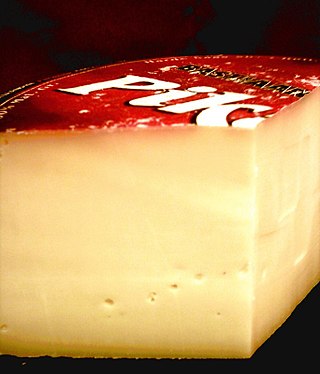
Cheddar cheese is a natural cheese that is relatively hard, off-white, and sometimes sharp-tasting. It originates from the English village of Cheddar in Somerset, South West England.

Van Wert is a city in and the county seat of Van Wert County, Ohio, United States. It is located in northwestern Ohio approximately 77 miles (124 km) southwest of Toledo and 34 miles (55 km) southeast of Fort Wayne, Indiana. The population was 11,092 at the 2020 census. It is the principal city of the Van Wert micropolitan area, which is included in the Lima–Van Wert–Wapakoneta combined statistical area.

Gouda cheese is a creamy, yellow cow's milk cheese originating from the Netherlands. It is one of the most popular and produced cheeses worldwide. The name is used today as a general term for numerous similar cheeses produced in the traditional Dutch manner.

Annatto is an orange-red condiment and food coloring derived from the seeds of the achiote tree, native to tropical parts of the Americas. It is often used to impart a yellow to red-orange color to foods, but sometimes also for its flavor and aroma. Its scent is described as "slightly peppery with a hint of nutmeg" and flavor as "slightly nutty, sweet and peppery".

Camembert is a moist, soft, creamy, surface-ripened cow's milk cheese. It was first made in the late 18th century in Camembert, Normandy, in northwest France. It is sometimes compared in look, taste and texture to brie cheese, albeit with a slightly lower butterfat content than brie's typical 20% – 25% by weight.

Cheesemaking is the craft of making cheese. The production of cheese, like many other food preservation processes, allows the nutritional and economic value of a food material, in this case milk, to be preserved in concentrated form. Cheesemaking allows the production of the cheese with diverse flavors and consistencies.

Blue cheese is any of a wide range of cheeses made with the addition of cultures of edible molds, which create blue-green spots or veins through the cheese. Blue cheeses vary in taste from very mild to strong, and from slightly sweet to salty or sharp; in colour from pale to dark; and in consistency from liquid to hard. They may have a distinctive smell, either from the mold or from various specially cultivated bacteria such as Brevibacterium linens.

Cheetos is a crunchy corn-cheese puff snack brand made by Frito-Lay, a subsidiary of PepsiCo. Fritos creator Charles Elmer Doolin invented Cheetos in 1948, and began national distribution in the United States. The initial success of Cheetos was a contributing factor to the merger between The Frito Company and H.W. Lay & Company in 1961 to form Frito-Lay. In 1965 Frito-Lay became a subsidiary of The Pepsi-Cola Company, forming PepsiCo, the current owner of the Cheetos brand.

Velveeta is a brand name for a processed cheese similar to American cheese. It was invented in 1918 by Emil Frey (1867–1951) of the Monroe Cheese Company in Monroe, New York. In 1923, The Velveeta Cheese Company was incorporated as a separate company. In 1925, it advertised two varieties, Swiss and American. The firm was purchased by Kraft Foods Inc. in 1927. Unlike Kraft Singles, which is real cheese, Velveeta does not count as real cheese due to reasons detailed below.

Borden, Inc., was an American producer of food and beverage products, consumer products, and industrial products. At one time, the company was the largest U.S. producer of dairy and pasta products. Its food division, Borden Foods, was based in Columbus, Ohio, and focused primarily on pasta and pasta sauces, bakery products, snacks, processed cheese, jams and jellies, and ice cream. It was best known for its Borden Ice Cream, Meadow Gold milk, Creamette pasta, and Borden Condensed Milk brands. Its consumer products and industrial segment marketed wallpaper, adhesives, plastics and resins. By 1993, sales of food products accounted for 67 percent of its revenue. It was also known for its Elmer's and Krazy Glue brands.

Marie Harel was a French cheesemaker, who, along with Abbot Charles-Jean Bonvoust, invented Camembert cheese, according to local legend.

Beecher's Handmade Cheese is an artisan cheesemaker with retail locations in the greater Seattle area and several airports. The company was founded by Kurt Beecher Dammeier in 2003 and opened in Pike Place Market after Dammeier acquired a difficult-to-obtain storefront lease in the Market. Because Dammeier had never been a cheesemaker, he sought out the assistance of Brad Sinko, who helped run a family cheesemaking business in Oregon. A second location was opened in 2011 Manhattan's Flatiron District; this closed in October, 2022.
Artisanal cheese refers to cheeses produced by hand using the traditional craftsmanship of skilled cheesemakers. As a result, the cheeses are often more complex in taste and variety. Many are aged and ripened to achieve certain aesthetics. This contrasts with the more mild flavors of mass-produced cheeses produced in large-scale operations, often shipped and sold right away.

Stichelton is an English blue cheese. It is similar to Blue Stilton cheese, except that it does not use pasteurised milk or factory-produced rennet. The name comes from a form of the name of Stilton village in the 1086 Domesday Book (Stichiltone/Sticiltone), as the name Stilton cannot legally be used for the cheese.
Daphne Zepos was a Greek-born author, chef, educator and cheese aficionado. At various times in her career, she was associated with the Artisanal Cheese Center, where she was employed as affineur, the Essex Street Cheese Company, the Cheese of Choice Coalition and was a co-owner of the Cheese School of San Francisco. She wrote articles about cheese for The Atlantic magazine.

Lore Alford Rogers was an American bacteriologist and dairy scientist. He is credited with discovering that butter made from pasteurized sweet cream remained fresher than that made from sour ripened cream, while suggesting that surplus milk could still be sold as concentrated sour milk products. He refined the steps for manufacture of high quality Swiss cheese and, new to the United States, production of Roquefort cheese. He was instrumental in finding ways to discourage fungal growth in sweetened condensed milk and preventing losses in evaporated milk from heat coagulation.

Limburger is a cheese that originated in the Herve area of the historical Duchy of Limburg, which had its capital in Limbourg-sur-Vesdre, now in the French-speaking Belgian province of Liège. The cheese is especially known for its strong smell caused by the bacterium Brevibacterium linens.














